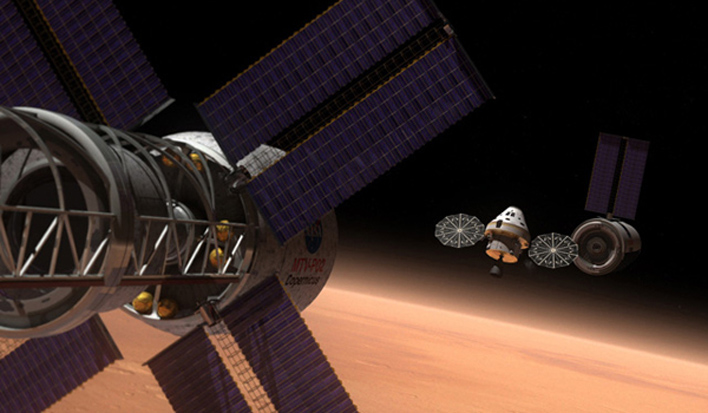
NASA has unveiled the design of its Multi-Purpose Crew Vehicle, the next-generation spaceship that will carry astronauts to an asteroid and then, later, to Mars. But don't get too attached to that clunky name; we'll be calling it something else soon enough.
MPCV is jargony NASA-speak for the new deep space vehicle, just as "Space Transportation System" refers to the space shuttle program (that's why shuttle Endeavour's last mission is STS-134, for example) and "Crew Exploration Vehicle" denotes the spaceship we know as Orion.
Or used to know as Orion. Under President George W. Bush's moon-oriented Constellation program, Orion was to provide astronaut transport, but President Barack Obama canceled Constellation last year in favor of sending humans to an asteroid by 2025 and Mars by the mid-2030s. [Photos: NASA's New Spaceship for Deep Space]
The new MPCV spaceship will be based on Orion's design but almost certainly will not take its name.
Anybody's guess
So what will the MPCV's new name be? It's anybody's guess, as NASA officials haven't announced one yet. They've been pretty preoccupied with selecting the final design of the spaceship and pondering details of the so-called Space Launch System (SLS), the heavy-lift rocket that will loft it to the heavens.
"To be honest with you, that's not been high on my priority list," Doug Cooke, associate administrator for NASA's Exploration Systems Mission Directorate in Washington, D.C., said of choosing a name. "We will think about those things, but right now we're trying to expend all of our energy on making progress and reaching our integrated approach to this vehicle development."
Get the Space.com Newsletter
Breaking space news, the latest updates on rocket launches, skywatching events and more!
But if you simply must place a bet on a new moniker, look to history as a guide. A little research shows there's a good chance that the name will reference a celestial object, a Greek or Roman god or a great thinker of long ago. [How Did the Space Shuttle Endeavour Get Its Name?]
There's Orion, for example, named after the famous constellation. Then there are the great missions and rockets of yesteryear — Apollo, Mercury, Gemini, Juno, Saturn. The unmanned Saturn-studying Cassini probe and the planet-hunting Kepler Space Telescope bear the names of long-dead scientists who deepened our understanding of the cosmos.
There are many other possibilities, of course. The space shuttle orbiters are all named after historic oceangoing research or exploration vessels. And NASA science probes often bear more generic names, such as Pioneer, Voyager and New Horizons.
Will NASA let us choose the name?
In most cases, NASA officials pick the name of a new spacecraft or rocket themselves, after carrying out an in-house study. But sometimes they let regular folks get involved.
In 1988, for example, NASA staged a national competition among elementary and secondary school students to hang a name on its new space shuttle orbiter (with the oceangoing-vessel stipulation still attached). The vehicle was a replacement for Challenger, which was lost along with its seven-astronaut crew in a 1986 accident.
The agency eventually selected the name "Endeavour" for the orbiter, which is currently making its final STS-134 flight to the International Space Station. [Photos: Shuttle Endeavour's Final Mission]
NASA also held a competition to name its twin golf-cart-size rovers Spirit and Opportunity, which touched down on the surface of Mars in 2004. More than 10,000 people had a go; the winning entry was submitted by a 9-year-old Arizona girl.
The newest Mars rover, the Mars Science Laboratory, was named Curiosity in 2009 by Clara Ma, a sixth-grader at the time who won a NASA naming contest to christen the Red Planet robot. Curiosity is slated to launch toward Mars in November.
But we're still not sure how or when NASA is going to pick a name for its new spaceship. So the decidedly unmellifluous "MPCV" will just have to do for now.
This story was provided by Life's Little Mysteries, a sister site to SPACE.com. You can follow SPACE.com senior writer Mike Wall on Twitter: @michaeldwall. Follow SPACE.com for the latest in space science and exploration news on Twitter @Spacedotcom and on Facebook.
Join our Space Forums to keep talking space on the latest missions, night sky and more! And if you have a news tip, correction or comment, let us know at: community@space.com.

Michael Wall is a Senior Space Writer with Space.com and joined the team in 2010. He primarily covers exoplanets, spaceflight and military space, but has been known to dabble in the space art beat. His book about the search for alien life, "Out There," was published on Nov. 13, 2018. Before becoming a science writer, Michael worked as a herpetologist and wildlife biologist. He has a Ph.D. in evolutionary biology from the University of Sydney, Australia, a bachelor's degree from the University of Arizona, and a graduate certificate in science writing from the University of California, Santa Cruz. To find out what his latest project is, you can follow Michael on Twitter.










